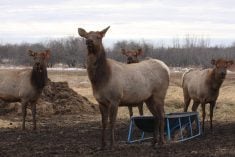Mother Nature froze hopes of a bumper crop in Saskatchewan and western Manitoba with unseasonably low overnight temperatures Aug. 20.
Carroll, Man., farmer Darrel Carlisle said the frost damage in his canola and peas has become more apparent over the weekend. His neighbour’s silage corn has turned black, he said.
“It didn’t kill everything off, but it sure downgraded us and definitely lost yield potential in the canola big time,” he said.
A bountiful crop, although later than normal due to a cool summer, was bolstered by timely rains and low disease and insect pressures this year.
Read Also

Trump cuts off trade talks with Canada
(Reuters) – U.S. President Donald Trump said on Thursday that all trade talks with Canada were terminated following what he…
Fears of early frost were realized for farmers like Carlisle on Aug. 20 when temperatures dipped as low as Ð3 C over a four-hour period in his area.
“No one around here believes it got that cold but the damage is showing up that it did get that cold,” Carlisle said.
His crops were safely in the bin by this time last summer but are now about three weeks behind normal.
He reported little impact from frost on his winter wheat but said it’s wait-and-see for the rest.
“One thing we can’t handle is any more frost. Another one would just finish it off,” Carlisle said.
Gary Cothill of Saskatchewan Agriculture said half of Saskatchewan’s agricultural areas received frost.
Crop damage will vary depending on the stage of the crops, he said.
“Late dough would sustain less injury than early dough,” he said.
“The farther along the crop is, the less damage there would be from frost.”
Cothill expected to see a shrivelling of the kernels and yield loss in many areas.
“It was broad enough and lasted long enough so there will be damage.”
Specialty crops and low-lying areas were hit especially hard, said Scott Day, agricultural representative with Manitoba Agriculture at Boissevain.
Corn leaves are drying out and dropping off and beans are turning black, he said of his region.
“It’s looking pretty bad,” he said, noting buckwheat was badly damaged.
“It dies if you breathe on it when it’s cold,” he said.
He doubted the sunflower crop would have made harvest, even without early frosts.
Some canola is turning white, tissues have ruptured and pods are leaking juice.
The extent of damage will not be known until harvest, but much remains in flower and appears in good shape when observed from a distance, said Day.
“There is a chance the seed being formed in pods is damaged and could shrivel or be poor quality due to high chlorophyll content,” he said.
This week’s canola watch report recommends delaying swathing until field assessments are done.
If the seeds remain turgid, it advises delaying swathing to allow for further seed maturity. If pods are damaged and drying up, swathing is recommended during periods of dew or high humidity to reduce the amount of pod drop and shelling.
Rob Park of Manitoba Agriculture confirmed significant damage to canola, sunflowers and flax, saying downgrades in quality and yields are likely.
“Damage will have a large local impact, but provincially it is a lot less significant,” he said, noting damage was highly variable.
Regions outside of the affected southwestern triangle in Manitoba continue to have strong, albeit late, crops.
“There’s a lot of acreage in Manitoba unaffected by this frost,” he said, noting cereals are virtually unaffected.
Markets initially reacted to word of frost but have since flattened out.
“There will not be a significant effect on the overall picture,” Park said.
The fate of silage corn remains uncertain, said Vern Racz, director of the Prairie Feed Resource Centre in Saskatoon.
“Corn was behind the eight ball even before Friday (Aug. 20),” said Racz.
He said corn failed to receive sufficient heat units and was significantly behind in its development.
Bob Cormier of Environment Canada reports that most of the grain belt in Saskatchewan and Manitoba saw frost last week, with Fort McMurray the only Alberta site reporting such lows.
Hardest hit was an area stretching from east of Saskatoon to Wadena-Yorkton and south to east of Regina, Fort Qu’Appelle and Estevan. Broadview recorded Ð2.9 C, with frost in eastern areas for up to five hours.
Southwestern Manitoba, south of Dauphin and including Brandon and Melita, were affected, with patchy frost also reported in the Red River Valley.
Unsettled weather and up to 40 millimetres of rain are in the forecast this week but no frost, said Cormier.














